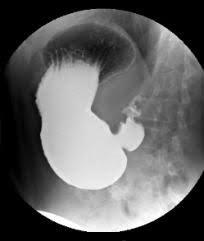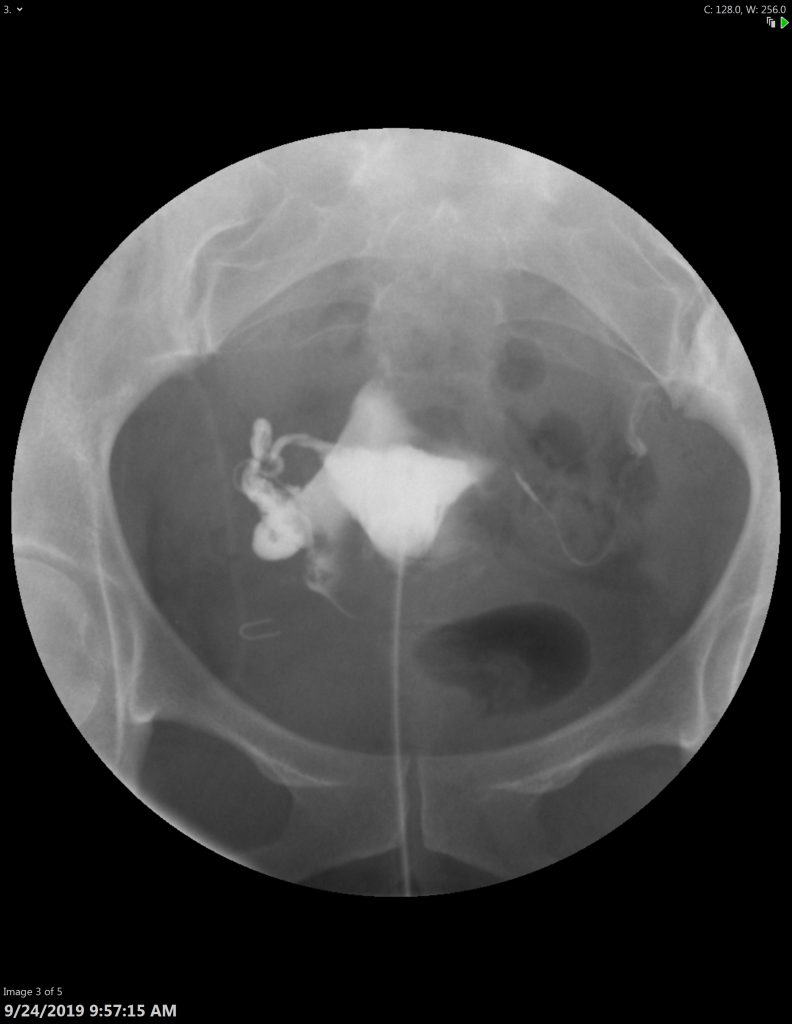
Fluoroscopy is a form of real-time X-RAY that employs a fluoroscope to examine the tissues and deep structures within the body. A fluoroscope is a device that projects radiographic images in a movie-like sequence onto a monitor. It is often used with contrast material which clearly defines the area being examined by making it appear darker. Fluoroscopy makes it possible to see internal organs in motion.
There are several types of Fluoroscopy:
- Upper Gastrointestinal (UGI)
- Barium Enema
- Hysterosalpingography (HSG)
UGI

Upper gastrointestinal tract radiography (upper GI) produces images of the esophagus, stomach and proximal small intestine with a barium-based contrast material. It is safe and noninvasive and may be used to help accurately diagnose pain, acid reflux, ulcers, blood in the stool and other symptoms. When the upper GI tract is coated with the barium-based contrast (which is given to the patient as a drink), the radiologist is able to view and assess the anatomy and function of the esophagus, stomach and duodenum (proximal small intestine).
During the Exam
During the exam, you will be asked to drink the liquid barium, which resembles a light-colored milkshake. The radiologist will then watch the barium pass through your digestive tract on the fluoroscope. The exam table will be positioned at different angles and your abdomen may be compressed to help spread the barium. Once the upper GI tract is adequately coated with the barium, X-RAY images will be captured and stored for further review.
Preparation
You may be asked to undress whatever part of your body needs examination. You may also be asked to remove jewelry, eyeglasses and any metal objects. You will be asked not to eat or drink after midnight prior to your exam. You may bring them with you to your exam and your technologist will inform you when to take medication after your exam has been completed.
Barium Enema

Lower gastrointestinal tract radiography (lower GI) also called a barium enema, produces images of the large intestine to help detect disease and abnormalities and diagnose the cause of, constipation or blood in the stool with the use of a barium-based contrast material. When the lower gastrointestinal tract is filled with the barium-based contrast (which is given to the patient through a tube in the rectum), the radiologist is able to view and assess the anatomy and function of the rectum, colon and sometimes part of the lower small intestine.
During the Exam
During the exam, you will be positioned on the examination table and an X-RAY will be taken to ensure your bowel is clean of stool. Then, the radiologist or technologist will insert a small tube into the rectum and begin to instill a mixture of barium and water into the colon. Once the lower GI tract is adequately coated with barium, X-RAY images will be taken and stored for further review. Once the X-RAY images are completed, most of the barium will be emptied through the tube. Any remaining barium can be expelled in the restroom.
Preparation
You may be asked to undress whatever part of your body needs examination. You may also be asked to remove jewelry, eyeglasses and any metal objects.
Click here for detailed preparation Instructions
HSG

HSG uses Fluoroscopy to examine the uterus and fallopian tubes of a woman who is having difficulty becoming pregnant. It’s also used to investigate miscarriages resulting from abnormalities within the uterus and to determine the presence and severity of adhesions or uterine fibroids tumor masses, adhesions, and uterine fibroids. Contrast material is administered through a catheter.
During the Exam
During the exam, you will be positioned on the exam table, with your knees bent or your feet held up with stirrups. A speculum is inserted into the vagina, similar to a routine gynecological exam. The cervix is then cleansed, and a catheter is inserted into the cervix. The speculum is removed and you will be carefully positioned underneath the Fluoroscopy camera. The contrast material then begins to fill the uterine cavity, fallopian tubes, and peritoneal cavity through the catheter and fluoroscopic images are taken and stored for further review.
Preparation
You may be asked to undress whatever part of your body needs examination. You may also be asked to remove jewelry, eyeglasses and any metal objects.
The hysterosalpingography procedure is best performed one week after menstruation but before ovulation to make certain that you are not pregnant during the exam. You should inform your physician of any medications being taken and if there are any allergies, especially to iodinated contrast materials.














